How Does an RV Propane Furnace Work?
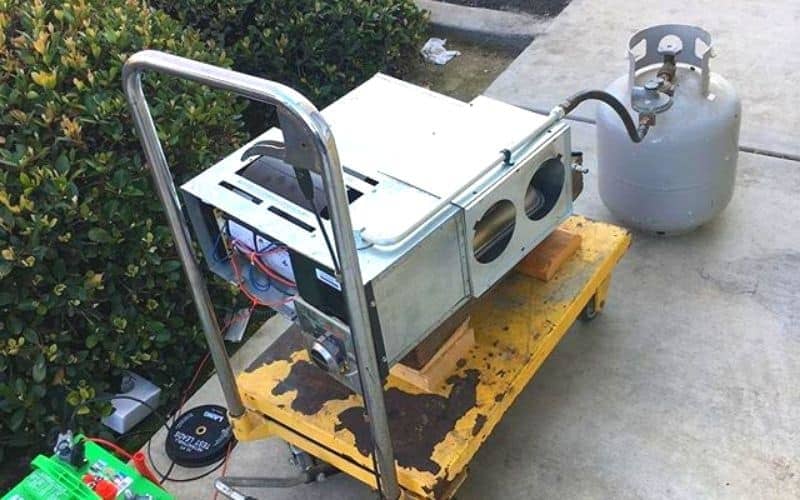
During the winter, plenty of RV campers choose to remain indoors. During winter people stay at home, not touring, and living the high life in a camper. On the other hand, others choose to be more innovative at this period. If you’re in the second category, we’ve got some great advice for you.
Even in the winter, RV camping is doable! Particularly if your camper comes with a propane-powered RV furnace. And how does a propane furnace in an RV work? In this article, we’ll explain how it works, and go into some crucial security, care, and problem-solving tips in this article. So, let’s start!
Table of Contents
How Does an RV Propane Furnace Work?
So How Does an RV Propane Furnace Work? Typically, an RV propane furnace works by using propane and electricity to operate. Propane is generating heat while the electricity turns on the fan for heat circulation. Most propane furnaces come with a thermostat, blower motor, a safety limit switch, and vents for air intake and exhaust.
For those who want to know about RVs in winter, be sure to read How to Keep RV Warm in Winter?
The Working Process Of RV Furnace
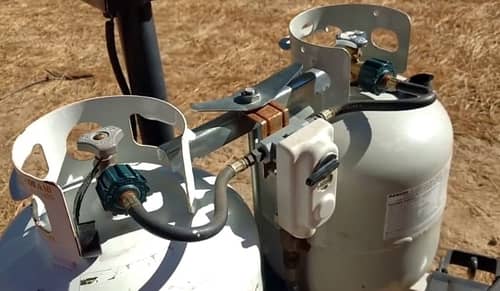
Basically, an RV furnace operates by using electricity or propane. The furnace system is heated by propane, while the fan is moved by electricity. Dealing with a forced-air system is simple since the only things you need are a thermostat, an electric fan, and ductwork.
The electric fan is triggered when the thermostat is set higher compared to the RV’s temperature. As propane ignites to generate hot air, the heater gradually warms your RV, while ducts in the process blast heated air out. Simply, an RV furnace’s operation will necessitate both propane and power: propane is producing hot air, together with electricity that switches the heating mode and activates the fans.
The process of installing a furnace in your RV is quite simple. Because the ducting often runs beneath the vehicle’s floor, this system will warm the RV and keep the tanks and pipes from being frozen.
What is the Best Propane Heater For Your RV?
Since you understand how an RV furnace works, you’re probably trying to decide what type of propane heater to purchase. If you want a ducted type of RV heater that works on propane, look for Dometic or Suburban designs, which are well-known for their quality, long-lasting design that can last for many years. These, on the other hand, are costly, and you will need to hire an expert to install them on your RV.
Space heaters are a good option if you have a limited budget and if you are looking for low-cost options. No matter if it’s a propane heater or an electric one, they’ll do the job without breaking the bank. Electric heaters are a great option for money-saving choice if your camping resorts have electric connectors. On the other side, propane heaters are a better choice for those who love staying outside while boondocking. In comparison to propane furnaces that are used for RVs, electric heaters use less fuel.
The disadvantage of this type of heater is that they do not keep the bottom of the RV warm, so the pipes and tanks are susceptible to freezing in very cold weather. Furthermore, multiple heaters may be required to keep your RV warm during winter.
What Amount Of Propane Is Used In RV Furnace?
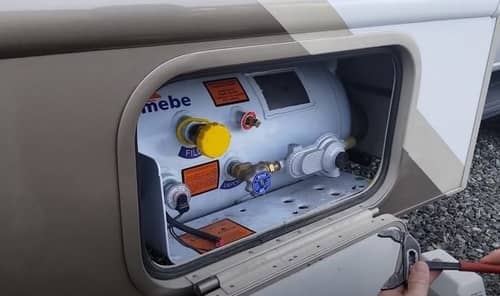
How much propane is used in an RV furnace is determined by a variety of factors, and one of them is BTU (British thermal unit) rating.
How long your propane RV furnace can work is determined by the volume of the propane tank. A standard 20-pound propane tank can store around 4.6 gallons of propane.
So, the question is how long a 20 lb propane tank is able to run an RV furnace?
Taking the foregoing example, multiply 4.6 (gallons in a 20-pound tank) by 2.3. A 20-pound propane tank can power an RV furnace for around 10.5 hours.
Tips to Run RV Furnace Properly
It is critical to extensively maintain a system in order for it to function properly. In this case, the same rules can be applied here. But nevertheless, taking care of a forced-air heater will not be a problem.
Ways to properly maintain your RV furnace:
- Ensure the ducts on your RV are properly connected to the furnace and the registers on a regular basis.
- Maintain the cleanliness of the furnace and registers.
- Examine the ducts for any tears, holes, or obstructions. When you find them, fix them right away.
- Keep the incoming exhaust vents and air spotless at all times.
Mice and birds are prone to find their way into vents in your motorhome because they are exposed to the outside elements. Dust and mold can also build up around registers over time, more so if you move across isolated places. As a result, it is highly advised that the RV furnace is maintained every year to assure the system is functioning properly.
Ways to Repair RV Propane Heater During Camping
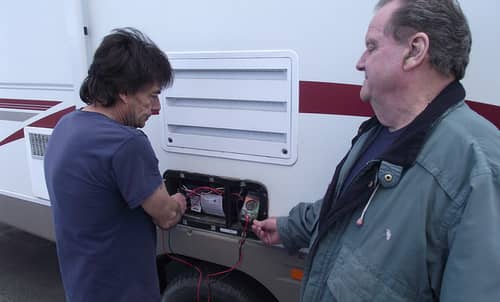
The gas furnace system may still fail even though the RV furnace that runs on propane is in excellent working order and you have to do one additional check before going camping. And to make things even worse, believe me, they break down when you least expect! Considering this, to address a few general issues, we bring you some maintenance tips for RV furnance.
1. Motor of RV Furnace Isn’t Working
When you turn on the RV heater, you’ll usually hear the motor blower that starts up. If there is no sound, it’s an indication of an electrical issue.
The question is: What are you going to do here?
First, furnace fuse must be checked. It might be blown out? If this is the case, simply install add a new fuse and your system will run again. However, if the problem with fuse is still present, the issue could be:
- a broken blower motor
- the thermostat
- Broken down module board
We advise that you have a licensed RV technician examine the heating system if the fuse isn’t the problem.
2. Motor of RV Furnace is Running While the System Isn’t Running Properly
If this is the case, first thing that you’ll notice is the blower motor that kick on, and that’s it. It indicates that you’re quite probably dealing with a faulty sail switch. In some situations, the switch could be trapped, in which case you’ll have to work a little harder to get it back on track. Sometimes the only option that can be done is to get a new switch. Here’s a brief video on how to troubleshoot an RV furnace with a clogged sail switch.
A bad relay, in addition to the switch problem, can complicate the situation. Here’s where you may test the voltage to see if it can assist you to fix the problem.
3. Pilot on RV Furnace Won’t Light
When the blower motor operates normally, and you can hear the clicking sound of thumping of the gas valve and the igniter, but the pilot will not light. The problem may be as trivial as air in your propane pipes, which must be purged.
A faulty gas valve, a misplaced igniter, or bugs could also be the source of the problem in this scenario. In the gas tubes, bugs can also easily be detected. As a result, carefully cleaning certain places may also eliminate the problem.
Tips For Propane Furnace Heaters
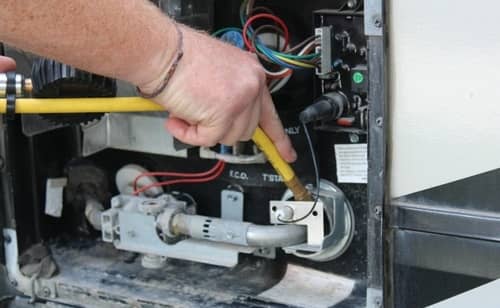
Safety First
Certain things must be taken when propane furnace is used. Then again, you should be ready for bad scenarios, such as a propane leak. Therefore, if you want to install a reliable propane furnace into RV, you should make sure it has both carbon monoxide and a propane detector. Ensure the RV propane detector is in good working order by testing it regularly. Keep in mind that this is very important!
Proper Ventilation
It is essential to produce the proper airflow for your RV furnace to function properly and effectively.
You must ensure the following things:
- The propane heater must be properly vented in your RV.
- The air intake is not interrupted.
When the furnace runs, don’t block the vents. This will make adequate ventilation easier.
Understanding the Process of RV Furnace
We’ve already talked about this, but let’s go over it again briefly. When you turn on the thermostat, it will take a few moments for furnace in your RV to run. Wait 30 to 60 seconds for warm air to start coming from the vents once it has begun to work. If you hear that the blower is running for some time, don’t be concerned. This is normal process, and you’ll notice it until the flame disappear and the proper temperature is reached.
Dusty Smell From RV Furnace
If your vent produces a dusty odor, don’t be concerned. Dust, dirt, and debris may have gathered in your vents and ducts for some period of time, and they will burn out when you turn your furnace on, leaving you with a nasty smell for a while.
Watch Out For Propane Smell
Even though the dusty odor isn’t a problem, the propane odor could be. Therefore, when you notice propane, turn off the LP gas and open the windows and doors of your vehicle to allow for proper ventilation. The next step is to try to figure out where the propane leaks.
Accumulation of Soot Around the Vent
If soot is forming around your vent, the oxygen and fuel in your RV are not properly combined. Fuel is not burned as a result of this. Check for soot and remove it if you find it to avoid this. Furthermore, to prevent soot accumulation, regulate the airflow that is connected to burner flame.
Inspect Gas Regulators
Each RV comes with LP gas regulators. They easily wear out over time, regardless of the RV type, style, or brand that you have. A faulty regulator can intensify furnace problems by reducing the effectiveness of your propane in RV.
To avoid this, you will need to change them regularly. If otherwise, as a bare minimum, inspect and maintain them on a regular basis. It’s not difficult to check your regulators. Things you need to do are the following; turn on the furnace and look at the burner flame. It’s fine if it appears blue. If the flame is yellow, you will also need to replace it.
For those who want to learn more, be sure to read How To Clean An RV Toilet? Expert Explains.
FAQ: People Also Ask
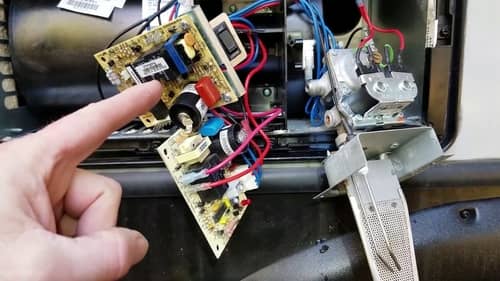
How long can RV furnace run on propane?
To keep you warm, it may just need to run for 8 minutes per hour. That means every 15 minutes or so, the furnace will turn on for 2 minutes. One gallon of propane will heat your RV for around 24 hours at that rate.
How much propane RV furnace uses per hour?
The average burn rate of a gallon of propane is 90,000-100,000 BTUs per hour. While running continuously for an hour, the average-sized RV furnace will burn roughly 1/3 gallon of propane. A gallon of propane equals 3 hours of continuous RV furnace use, according to this calculation.
Does RV furnace run off propane or electric?
Although your RV’s furnace may use electricity to burn or control the thermostat, practically all aboard RV furnaces work on liquid propane, which is a rather efficient fuel source.
Final Thoughts
Now that we’ve gone through everything about how RV Propane Furnace Work, I hope you’ve learned and understood the basics. It is very important to check the system from time to time to make it work properly. Also if you have additional questions, feel free to contact us or leave a comment below.

I don’t think the title of your article matches the content lol. Just kidding, mainly because I had some doubts after reading the article. https://accounts.binance.com/it/register-person?ref=B4EPR6J0
Can you be more specific about the content of your article? After reading it, I still have some doubts. Hope you can help me. https://accounts.binance.com/de-CH/register?ref=FIHEGIZ8
Thanks for sharing. I read many of your blog posts, cool, your blog is very good.